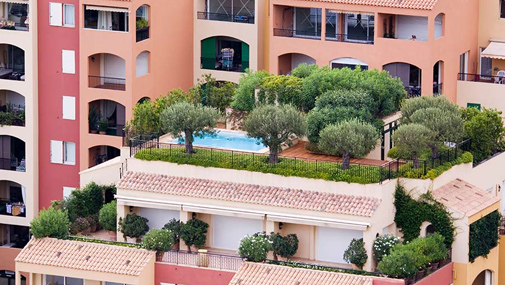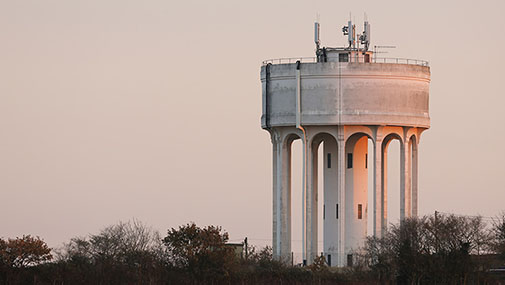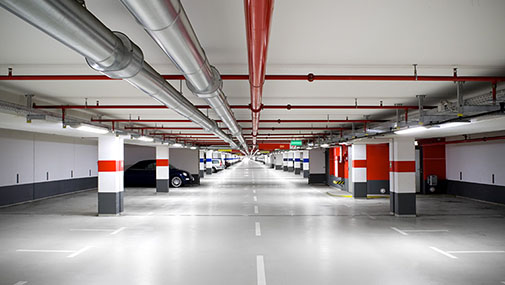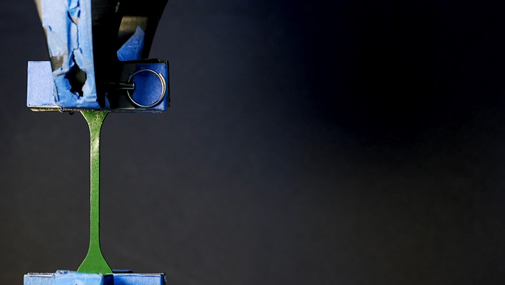Liquid waterproofing membranes
Contents
- Advantages of liquid waterproofing membranes
- Uses for liquid waterproofing membranes
- Cold vs. hot waterproofing
Liquid applied waterproofing is essential for protecting many building structures. These flexible membranes are hand or spray applied onto surfaces such as balconies, podium decks and green roofs. They are even used to line municipal water tanks to prevent leaks. This type of protection is also used to help extend the service life of structures such as car parks.
Advantages of liquid waterproofing membranes
Liquid applied waterproofing offers many advantages, including:
- Ease of application — Liquid waterproofing can often be applied quickly. Depending on the product, a three-man crew can apply 930 square metres of spray-applied waterproofing in just one day. These advantages become even more pronounced when waterproofing complex spaces or spaces with lots of detailing, since it’s easier to waterproof pipes and other penetrations with liquid than it is by cutting and placing sheet membranes.
-
Seamless — Liquid applied waterproofing cures to form one solid membrane, so there are no seams or joints, which are the most common areas where waterproofing tends to fail.
-
Flexibility — The best performing liquid waterproofing systems have the flexibility to expand and contract as the temperature changes, and adapt to minor structural movements. This way, the waterproofing continues to perform, even when exposed to extreme weather and/or when small concrete cracks occur in the underlying structure.
Uses for liquid waterproofing membranes
Liquid waterproofing membranes are commonly used for a wide range of applications, such as:
- Green roofs — Liquid applied waterproofing membranes work well for protecting green roofs. Typically, green roofs have a lot of penetrations for irrigation. Liquid waterproofing is easy to apply to detailing. Be sure that whatever waterproofing system you select is compatible with the green roof assembly and has been proven in similar environments.
If you’re planning a green roof project, be sure that the waterproofing system you choose passes long-term root resistance tests so that it isn’t damaged as plants take hold.
- Buried roofs — A buried roof is often a section of a basement that extends beyond the main elevation and is typically part of an under-garden structure or landscaped area. An elevated deck that’s used by people or cars may also be categorized as a buried roof structure.
Waterproofing systems for buried roofs need to last for the life of the structure, because making repairs on the waterproofing system is disruptive for the owners and the occupants of the building.
Look for a waterproofing system that’s extremely durable and also offers flexibility to adapt to changes in temperature and other factors that can degrade some waterproofing membranes. Having a tight bond between the waterproofing system and the substrate is also critical to prevent water from migrating beneath the surface.
- Inverted roofs — Some projects, such as rooftop terraces, use an inverted roof design. In these scenarios, the waterproofing layer is installed beneath the roof's traditional insulation. Insulation is placed on top of the liquid waterproofing membrane and held in place with paving slabs or gravel. The seamless nature of liquid waterproofing makes it appropriate for these projects. The liquid is easy to apply. Once it cures, it forms one solid membrane that is resistant to leaks.
- Roof refurbishment — Liquid waterproofing can be a good solution for repairing roof leaks. It can be applied on uneven surfaces, which are common in roof repair projects. The type of waterproofing needed will depend on many factors, including the extent of the leaks and whether the existing waterproofing system needs to be completely removed or simply patched. Regardless of whether you’re repairing an existing membrane or completely removing and replacing the existing waterproofing membrane, it is usually best to choose a fast curing liquid waterproofing system so you can complete the work quickly and efficiently.
- Water tanks — Water tanks of all kinds—from storm water tanks to potable water tanks—need to be waterproofed to protect against leaks caused by an array of sources. Even small cracks or fissures in concrete or steel water tanks can result in significant water leaks. There are some liquid waterproofing membranes such as SILCOR® liquid waterproofing that can be applied to the interior of the water tank to extend the life of the structure. This is an attractive solution because it can be used both to waterproof the tank as well as pipes and other penetrations. SILCOR® liquid waterproofing can also be used to line the inside of underground drinking water tanks, keeping the community’s drinking water safe by protecting it from contaminants in the groundwater. SILCOR 990MP is also approved for use to line the interior of potable water tanks in Asia Pacific, according to British Standard BS6920.
- Car parks — These structures can begin to deteriorate over time if they aren’t waterproofed, leading to costly structural problems. Underground car parks need protection from groundwater while exposed car parks need protection from rainwater.
Car parks have special requirements, including the need to stand up to considerable foot traffic. In addition, most car parks require waterproofing systems that are durable enough to withstand extremes in temperature and are skid resistant for safety.
Cold vs. hot waterproofing
In the past, general contractors relied on hot applied waterproofing due to its low cost and ability to adhere well to substrates.
Depending on the region, GCs may face additional permitting, have to pay extra for onsite fire marshals and/or face obstacles with securing liability insurance. For many GCs, the added hassles mean hot applied waterproofing no longer makes sense, particularly when there are cold applied waterproofing options available that offer the same or better adhesion properties.
Top 5 reasons to use liquid waterproofing
Green roofs are growing like wild
Planning a green roof project
Best practices for waterproofing a buried roof
Waterproofing systems for inverted roofs
Learn more about roof repair
Protecting drinking water supplies
Protecting the life of a car park
Cold vs. hot-applied waterproofing
Tags
- Building Envelope Solutions
- Silcor®
- Sustainability
- Waterproofing








